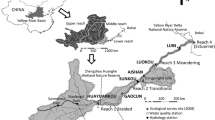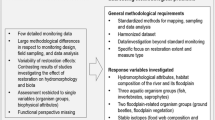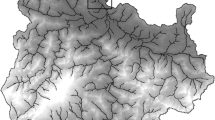Abstract
AusRivAS is an Australia-wide program that measures river condition using predictive models to compare the macroinvertebrate families occurring at a river site with those expected if the site were in natural condition. Results of assessment of 685 sites across all major rivers in Western Australia are presented. Most rivers were in relatively natural condition in the northern half of the state where the human population is low and pastoralism is the major land use. In the south, where the human population is higher and agriculture is more intensive, rivers were mostly more disturbed. AusRivAS assessment produced some erroneous results in rivers of the south-west cropping zone because of the lack of appropriate reference site groups and biased distribution of sampling sites. Collecting low numbers of animals from many forested streams, because of low stream productivity and samples that were difficult to sort, also affected assessments. Overall, however, AusRivAs assessment identified catchment processes that were inimical to river health. These processes included salinisation, high nutrient and organic loads, erosion and loss of riparian vegetation. River regulation, channel modification and fire were also associated with river degradation. As is the case with other assessment methods, one-off sampling at individual sites using AusRivAS may be misleading. Seasonal drought, in particular, may make it difficult to relate conditions at the time of sampling to longer-term river health. AusRivAS has shown river condition in Western Australia is not markedly different from other parts of Australia which, as a whole, lacks the substantial segments of severely degraded river systems reported in England.
Similar content being viewed by others
References
Anonymous (1984). Streamflow records of Western Australia to 1982. 3 vols. Perth, Western Australia: Public Works Department.
Borg, H., Hordacre, A., & Batini, F. (1988). Effects of logging in stream and river buffers on watercourses and water quality in the southern forest of Western Australia. Australian Forestry, 51, 98’05.
Bunn, S. E. (1988). Processing of leaf litter in two northern Jarrah forest streams, Western Australia. II. The role of macroinvertebrates and the influence of soluble polyphenols and inorganic sediment. Hydrobiologia, 162, 211’23.
Bunn, S. E., & Davies, P. M. (1990). Why is the stream fauna of south-western Australia so impoverished? Hydrobiologia, 194, 169’76.
Clarke, C. J., George, R. J., Bell, R. W., & Hatton, T. J. (2002). Dryland salinity in south-western Australia: Its origins, remedies, and future research directions. Australian Journal of Soil Research, 40, 93’13.
Courtemanch, D. L. (1996). Commentary on the subsampling procedures used for rapid bioassessments. Journal of the North American Benthological Society, 15, 381’85.
Davies, P. E. (2000). Development of a national river bioassessment system (AusRivAS) in Australia. In J. F. Wright, D. W. Sutcliffe, & M. T. Furse (Eds.), Assessing the biological quality of fresh waters (pp. 113’24). Ambleside: Freshwater Biological Association.
Gentilli, J. (1971). The main climatological elements. In J. Gentilli (Ed.), World survey of climatology, vol. 13: Climates of Australia and New Zealand (pp. 119’88). Amsterdam: Elsevier.
Growns, J. E., Chessman, B. C., Jackson, J. E., & Ross, D. G. (1997). Rapid assessment of Australian rivers using macroinvertebrates: Cost and efficiency of six methods of sample processing. Journal of the North American Benthological Society, 16, 682’93.
Halse, S. A., & Blyth, J. D. (1992). Aquatic fauna of the Karri Forest. In Research on the impact of forest management in South-west Western Australia (pp. 115’38). Occasional Paper 2/1992. Perth, Western Australia: Department of Conservation and Land Management.
Halse, S. A., Ruprecht, J. K., & Pinder, A. M. (2003). Salinisation and prospects for biodiversity in rivers and wetlands of south-west Western Australia. Australian Journal of Botany, 51, 673’88.
Halse, S., Smith, M., Kay, W., Scanlon, M., & Cocking, J. (2002a). Australia-wide Assessment of River Health: Western Australian AusRivAS Sampling and Processing Manual. Monitoring River Health Initiative Technical Report 18. Canberra, Australian Capital Territory: Commonwealth of Australia http://www.deh.gov.au/water/rivers/nrhp/manual-wa/pubs/manual-wa.pdf.
Halse, S. A., Scanlon, M. D., & Cocking, J. S. (2002b). Australia-wide Assessment of River Health: Western Australian Bioassessment Report (WA Final Report). Monitoring River Health Technical Report 7. Canberra, Australian Capital Territory: Commonwealth of Australia http://www.deh.gov.au/water/rivers/nrhp/wa/pubs/wa.pdf.
Hemsley-Flint, B. (2000). Classification of the biological quality of rivers in England and Wales. In J. F. Wright, D. W. Sutcliffe, & M. T. Furse (Eds.), Assessing the biological quality of fresh waters: RIVPACS and other techniques (pp. 55’9). Ambleside, UK: Freshwater Biological Association.
Humphrey, C. L., Storey, A. W., & Thurtell, L. (2000). AUSRIVAS: Operator sample processing errors and temporal variability ’implications for model sensitivity. In J. F. Wright, D. W. Sutcliffe, & M. T. Furse (Eds.), Assessing the biological quality of freshwaters. RIVPACS and similar techniques (pp. 143’63). Ambleside, UK: Freshwater Biological Association.
Kay, W. R., Halse, S. A., Scanlon, M. D., & Smith, M. J. (2001). Distribution and environmental tolerances of aquatic macroinvertebrate families in the agricultural zone of south-western Australia. Journal of the North American Benthological Society, 20, 182’99.
Kay, W. R., Smith, M. J., Pinder, A. M., McRae, J. M., Davis, J. A., & Halse, S. A. (1999). Patterns of distribution of macroinvertebrate families in rivers of north-western Australia. Freshwater Biology, 41, 299’16.
Kelly, P. C. (1995). Western Australian year book 1995. Perth, Western Australia: Australian Government.
Lake, P. S. (2003). Ecological effects of perturbation by drought in flowing waters. Freshwater Biology, 48, 1161’172.
Marchant, R., Hirst, A., Norris, R. H., Butcher, R., Metzling, L., & Tiller, D. (1997). Classification and prediction of the macroinvertebrate assemblages from running waters in Victoria, Australia. Journal of the North American Benthological Society, 16, 664’81.
Metzling, L., Chessman, B., Hardwick, R., & Wong, V. (2003). Rapid assessment of rivers using macroinvertebrates: The role of experience, and comparisons with quantitative methods. Hydrobiologia, 510, 39’2.
NLWRA (2002). Australian catchment, river and estuary assessment. Canberra, Australian Capital Territory: Land & Water Australia.
Norris, R. H., & Georges, A. (1986). Design and analysis for assessment of water quality. In P. De Deckker & W. D. Williams (Eds.), Limnology in Australia (pp. 554’72). Melbourne: CSIRO.
Norris, R. H., & Thoms, M. C. (1999). What is river health? Freshwater Biology, 41, 197’09.
Pinder, A. M., Halse, S. A., McRae, J. M., & Shiel, R. J. (2004). Aquatic invertebrate assemblages of wetlands and rivers in the Wheatbelt region of Western Australia. Records of the Western Australian Museum. Supplements, 67, 7’7.
Pinder, A. M., Halse, S. A., McRae, J. M., & Shiel, R. J. (2005). Occurrence of aquatic invertebrates of the Wheatbelt region of Western Australia in relation to salinity. Hydrobiologia, 543, 1’4.
Reynoldson, T. B., & Wright, J. F. (2000). The reference condition: Problems and solutions. In J. F. Wright, D. W. Sutcliffe, & M. T. Furse (Eds.), Assessing the biological quality of fresh waters: RIVPACS and other techniques (pp. 305’09). Ambleside: Freshwater Biological Association.
Robinson, C. T., Aebischer, S., & Uehlinger, U. (2004). Immediate and habitat-specific responses of macroinvertebrates to sequential, experimental floods. Journal of the North American Benthological Society, 23, 853’67.
Schofield, N. J., & Davies, P. E. (1996). Measuring the health of our rivers. Water, May/June, 39’3.
Scrimgeour, G. J., Davidson, R. J., & Davidson, J. M. (1988). Recovery of benthic macroinvertebrate and epilithic communities following a large flood in an unstable, braided, New Zealand river. New Zealand Journal of Marine and Freshwater Resources, 22, 337’44.
Simpson, J. C., & Norris, R. H. (2000). Biological assessment of river quality: Development of AUSRIVAS models and outputs. In J. F. Wright, D. W. Sutcliffe, & M. T. Furse (Eds.), Assessing the biological quality of fresh waters: RIVPACS and other techniques (pp. 125’42). Ambleside: Freshwater Biological Association.
Smith, M. J., Kay, W. R., Edward, D. H. D., Papas, P. J., Richardson, K. S. J., Simpson, J. C., et al. (1999). AUSRIVAS: Using macroinvertebrates to assess ecological condition of rivers in Western Australia. Freshwater Biology, 41, 269’82.
Thackway, R., & Cresswell, I. D. (Eds.) (1995). An interim biogeographic regionalisation for Australia: A framework for establishing the national system of reserves, version 4.0. Canberra, Australian Capital Territory: Australian Nature Conservation Agency.
Townsend, C. R., & Scarsbrook, M. R. (1997). The intermediate disturbance hypothesis, refugia, and biodiversity in streams. Limnology and Oceanography, 42, 938’49.
Trayler, K. M., & Davis, J. A. (1998). Forestry impacts and the vertical distribution of stream invertebrates in south-western Australia. Freshwater Biology, 40, 331’42.
Turak, E., Hose, G., & Waddell, N. (2002). Australia-wide Assessment of River Health: New South Wales Bioassessment Report. Monitoring River Health Initiative Technical Report 2a. Canberra, Australian Capital Territory: Commonwealth of Australia http://www.deh.gov.au/water/rivers/nrhp/nsw/pubs/nsw1.pdf.
Vinson, M. R., & Hawkins, C. P. (1996). Effects of sampling area and subsampling procedure on comparisons of taxa richness among streams. Journal of the North American Benthological Society, 15, 392’99.
Williams, W. D. (1999). Salinisation: Major threat to water resources in the arid and semi-arid regions of the world. Lakes and Reservoirs: Research & Management, 4, 85’1.
WRC (1997). The state of the northern rivers. Perth, Western Australia: Water and Rivers Commission.
Wright, J. F. (2000). An introduction to RIVPACS. In J. F. Wright, D. W. Sutcliffe, & M. T. Furse (Eds.), Assessing the biological quality of fresh waters (pp. 1’4). Ambleside, UK: Freshwater Biological Association.
Author information
Authors and Affiliations
Corresponding author
Rights and permissions
About this article
Cite this article
Halse, S.A., Scanlon, M.D., Cocking, J.S. et al. Factors affecting river health and its assessment over broad geographic ranges: The Western Australian experience. Environ Monit Assess 134, 161–175 (2007). https://doi.org/10.1007/s10661-007-9607-4
Received:
Accepted:
Published:
Issue Date:
DOI: https://doi.org/10.1007/s10661-007-9607-4




